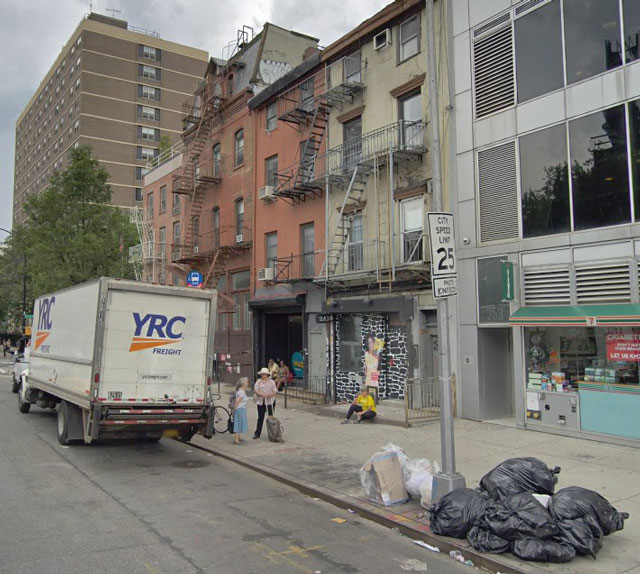The Bowery at East 4th Street, Manhattan
 |
| Bowery at East 4th Street, NYC, in 1980. |
Some Manhattan neighborhoods a bit off the beaten path have gone through wild swings over the decades. The Bowery is one of them. Readers who are not from New York City or the surrounding area may not get some of the nuances of certain streets. The Bowery (and it is always called "the Bowery" for historical reasons) is the oldest thoroughfare on Manhattan Island. It originally was a native American path before the Dutch built a road on it. The entire area at that time was farmland, so the Dutch named the path/road Bouwerij road – "bouwerij" being their word for "farm." Peter Stuyvesant, the most famous leader of the Dutch on Manhattan Island, had a farm near the Bowery. It is one of those streets which predated the 1811 grid pattern and thus runs in a somewhat eccentric direction which just coincidentally happens to almost conform to it (unlike, say, Broadway). As one of the most historic streets in the city, it deserves more respect than it has been shown over the hundreds of years since the British took control of the island. When I saw the above picture of the Bowery from 1980, it brought back some memories. So, I decided to do
a comparison of the Bowery at East 4th Street from 1980 to 2018.
 |
| 357 Bowery, NYC, in July 2018 (Google Street View). |
I wasn't sure from the original photo where to begin looking aside from the street name. The first objective always is to get the exact location on Google Maps. I had little to go on, just a notation that it was on "The Bowery," until I noticed the number on the second floor of the building on the left. It turned out to be the street number, and also happened to still be there (though the rest of the writing appears to have been scrubbed off). So, I knew I had the right spot at least, 357 Bowery, which is just south of East 4th Street. While this area doesn't really have an identity of its own beyond being "The Bowery," it can be considered part of the Lower East Side.
 |
| 357 Bowery, NYC, in July 2018 (Google Street View). |
Well, 357 Bowery is just another address, right, so what's the big deal? They look like typical mid-19th Century row houses. Well, we can see a lot from the 1980 photo that tells a story. The Bowery got extremely run down during the second half of the 20th Century. The phrase "Bowery bum" became common, because, for whatever reasons, the drunk and the destitute tended to gravitate to that area. As shown in the photo from 1980, the photographer apparently was trying to capture the desolation of the Bowery, with tramps in the street and the buildings looking like they come from a dystopian future. The 19th Century lettering on the building helped to take the scene into another dimension, one where the surroundings were relics from the 1890s and "progress" of the 20th Century never happened.
 |
| 357 Bowery, NYC, in July 2018 (Google Street View). |
Well, the good news is that The Bowery has moved beyond its worst period, although it hasn't exactly become the most beautiful spot in Manhattan. As the recent photos show, the worst defacements of the buildings are gone, though there is still some graffiti and also the old roll-down steel shutters in places. There's still trash in the street, but at least now it is neatly piled in bags for pickup. The bums are gone, though there are still people just "hanging out." It's a different scene, but you can definitely see the connection between then and now. Personally, I would have kept the old lettering on that building, I love that historic stuff, but at least they retained the street number. Plus, 357 has new windows, but they don't detract from the building's quaint appearance. Overall, it's a much nicer scene, but still the same scene. And, that's kind of nice.
I hope you enjoyed this entry in our "the more things change, the more things stay the same" series. Sometimes the present is a distant reflection of the past, and that is the case with The Bowery at East 4th Street. Please visit the other pages in this series to see how a city evolves over time!.
2019




No comments:
Post a Comment